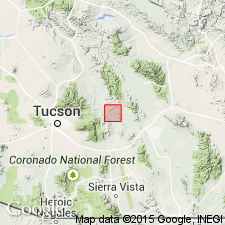
- Usage in publication:
-
- Cascabel Formation
- Modifications:
-
- First used
- Dominant lithology:
-
- Conglomerate
- Sandstone
- AAPG geologic province:
-
- Pedregosa basin
Summary:
First published use. Named for Cascabel 3 km SW of nearest exposures, Hot Springs Canyon, Galiuro Mountains, Cochise Co, AZ, Pedregosa basin. [Used in 1985 by authors in their theses.] Geologic map; cross section. No type locality. Consists mostly of red-brown to brown-gray polymictic cobble to boulder conglomerate; some subordinate red-brown to red-gray lithic sandstone; some interbedded mudstone. Conglomerate occurs as massive beds; clasts of sandstone, volcanics, granite rounded to well rounded, range 1-3 m in size; derived from Willow Canyon Formation, Muleshoe Volcanics (new name), and Precambrian. Lower member about 400 m thick of thick-bedded, clast- and matrix-supported cobble to boulder conglomerate that upward is interbedded with sandstone. Middle member about 150 m thick of medium-bedded, massive to cross-bedded, fine- to coarse-grained sandstone with minor pebble conglomerate interbeds. Upper member 400 m thick of thick-bedded, clast- and matrix-supported cobble to boulder conglomerate. A debris-flow, braided channel, alluvial fan deposit. Basal contact with Muleshoe depositional. Upper contact unconformable with Mineta Formation, Galiuro Volcanics, or Quiburis Formation. Unfossiliferous. Age constrained by 75 Ma date on Muleshoe and by lithic similarity to Fort Crittenden Formation; assigned mainly to Maastrichtian, may also be Paleocene?. Previously mapped with Muleshoe as an undivided Cretaceous or Paleocene unit.
Source: GNU records (USGS DDS-6; Denver GNULEX).
For more information, please contact Nancy Stamm, Geologic Names Committee Secretary.
Asterisk (*) indicates published by U.S. Geological Survey authors.
"No current usage" (†) implies that a name has been abandoned or has fallen into disuse. Former usage and, if known, replacement name given in parentheses ( ).
Slash (/) indicates name conflicts with nomenclatural guidelines (CSN, 1933; ACSN, 1961, 1970; NACSN, 1983, 2005, 2021). May be explained within brackets ([ ]).

